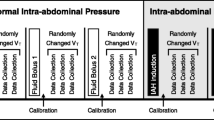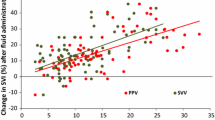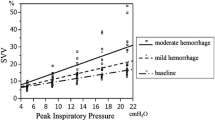Abstract
Objective
Stroke volume variation (SVV) during controlled mechanical ventilation is a useful predictor in response to volume expansion, and pleth variability index (PVI), a novel algorithm allowing for automated and continuous calculation of the respiratory variations in the pulse oximeter waveform amplitude, can also predict fluid responsiveness non-invasively in mechanically ventilated patients. The aim of this study was (1) to determine whether acute fluid infusion affects SVV and PVI, and (2) to compare the two values in the case of acute fluid infusion after a preoperative fast following general anesthesia induction.
Methods
After tracheal intubation, the patients’ lungs were mechanically ventilated. Subjects were anesthetized using sevoflurane and were given a rapid, constant-rate infusion of crystalloid (500 ml in 15 min). Systolic arterial pressure (SAP), diastolic arterial pressure (DAP), heart rate (HR), cardiac output (CO), cardiac index (CI), SVV, and PVI were measured at baseline and after 250 and 500 ml had been infused, and these values were compared.
Results
SAP, DAP, CO, and CI were unchanged after the infusion. HR and SVV decreased significantly after the infusion. SVI increased significantly after the infusion. There was a significant difference in PVI only between the post 250 ml and post 500 ml infusions.
Conclusions
A rapid infusion of 250–500 ml of a crystalloid in nearly healthy subjects who had fasted overnight returned their SVV to within the normal range. In such cases, SVV is a more sensitive predictor of fluid responsiveness than is PVI, and the infusion gradually increased SVI.
Similar content being viewed by others
References
Michard F. Changes in arterial pressure during mechanical ventilation. Anesthesiology. 2005;103:419–28.
Kramer A, Zygun D, Hawes H, Easton P, Ferland A. Pulse pressure variation predicts fluid responsiveness following coronary artery bypass surgery. Chest. 2004;126:1563–8.
Cannesson M, Desebbe O, Rosamel P, Delannoy B, Robin J, Bastien O, Lehot JJ. Pleth variability index to monitor the respiratory variations in the pulse oximeter plethysmographic waveform amplitude and predict fluid responsiveness in the operating theatre. Br J Anaesth. 2008;101:200–6.
Cannesson M, Delannoy B, Morand A, Rosamel P, Attof Y, Bastien O, Lehot JJ. Does the Pleth variability index indicate the respiratory-induced variation in the plethysmogram and arterial pressure waveforms? Anesth Analg. 2008;106:1189–94.
Keller G, Cassar E, Desebbe O, Lehot JJ, Cannesson M. Ability of pleth variability index to detect hemodynamic changes induced by passive leg raising in spontaneously breathing volunteers. Crit Care. 2008;12:R37.
Keane PW, Murray PF. Intravenous fluids in minor surgery. Their effect on recovery from anaesthesia. Anaesthesia. 1986;41:635–7.
Holte K, Kehlet H. Compensatory fluid administration for preoperative dehydration—does it improve outcome? Acta Anaesthesiol Scand. 2002;46:1089–93.
Kaye AD, Kucera IJ. Intravascular fluid and electrolyte physiology. In: Miller RD, editor. Miller’s anesthesia. 6th ed. Philadelphia, Pennsylvania: Churchill Livingstone; 2005. p. 1763–98.
Cannesson M, Musard H, Desebbe O, Boucau C, Simon R, Hénaine R, Lehot JJ. The ability of stroke volume variations obtained with Vigileo/FloTrac system to monitor fluid responsiveness in mechanically ventilated patients. Anesth Analg. 2009;108:513–7.
Kobayashi M, Koh M, Irinoda T, Meguro E, Hayakawa, Takagane A. Stroke volume variation as a predictor of intravascular volume depression and possible hypotension during the early postoperative period after esophagectomy. Ann Surg Oncol. 2009;16:1371–7.
Michard F, Boussat S, Chemla D, Anguel N, Mercat A, Lecarpentier Y, Richard C, Pinsky MR, Teboul JL. Relation between respiratory changes in arterial pulse pressure and fluid responsiveness in septic patients with acute circulatory failure. Am J Respir Crit Care Med. 2000;162:134–8.
Biais M, Nouette-Gaulain K, Cottenceau V, Revel P, Sztark F. Uncalibrated pulse contour-derived stroke volume variation predicts fluid responsiveness in mechanically ventilated patients undergoing liver transplantation. Br J Anaesth. 2008;101:761–8.
Morley D, Litwak K, Ferber P, Spence P, Dowling R, Meyns B, Griffith B, Burkhoff D. Hemodynamic effects of partial ventricular support in chronic heart failure: results of simulation validated with in vivo data. J Thorac Cardiovasc Surg. 2007;133:21–8.
Gelman S. Venous function and central venous pressure: a physiologic story. Anesthesiology. 2008;108:735–48.
Kaneda T, Suzuki T. Evaluation of circulatory state using pulse oximeter: 2. PI (perfusion index) · PVI (pleth variability index). Masui. 2009;58:860–5.
Svensen CH, Rodhe PM, Olsson J, Børsheim E, Aarsland A, Hahn RG. Arteriovenous differences in plasma dilution and the distribution kinetics of lactated ringer’s solution. Anesth Analg. 2009;108:128–33.
Drobin D, Hahn RG. Volume kinetics of Ringer’s solution in hypovolemic volunteers. Anesthesiology. 1999;90:81–91.
Huang CC, Fu JY, Hu HC, Kao KC, Chen NH, Hsieh MJ, Tsai YH. Prediction of fluid responsiveness in acute respiratory distress syndrome patients ventilated with low tidal volume and high positive end-expiratory pressure. Crit Care Med. 2008;36:2810–6.
Renner J, Gruenewald M, Quaden R, Hanss R, Meybohm P, Steinfath M, Scholz J, Bein B. Influence of increased intra-abdominal pressure on fluid responsiveness predicted by pulse pressure variation and stroke volume variation in a porcine model. Crit Care Med. 2009;37:650–8.
Rooke GA, Schwid HA, Shapira Y. The effect of graded hemorrhage and intravascular volume replacement on systolic pressure variation in humans during mechanical and spontaneous ventilation. Anesth Analg. 1995;80:925–32.
Perel A. Assessing fluid responsiveness by the systolic pressure variation in mechanically ventilated patients. Systolic pressure variation as a guide to fluid therapy in patients with sepsis-induced hypotension. Anesthesiology. 1998;89:1309–10.
Parry-Jones AJD, Pittman JAL. Arterial pressure and stroke volume variability as measurement for cardiovascular optimisation. Int J Intensive Care 2003; SUMMER: 67–72.
Sjöstrand F, Hahn RG. Volume kinetics of glucose 2.5% solution during laparoscopic cholecystectomy. Br J Anaesth. 2004;92:485–92.
Ewaldsson CA, Hahn RG. Kinetics and extravascular retention of acetated ringer’s solution during isoflurane or propofol anesthesia for thyroid surgery. Anesthesiology. 2005;103:460–9.
Jacob M, Chappell D, Conzen P, Finsterer U, Rehm M. Blood volume is normal after pre-operative overnight fasting. Acta Anaesthesiol Scand. 2008;52:522–9.
Pearson TC, Guthrie DL, Simpson J, Chinn S, Barosi G, Ferrant A, Lewis SM, Najean Y. Interpretation of measured red cell mass and plasma volume in adults: expert panel on radionuclides of the international council for standardization in haematology. Br J Haematol. 1995;89:748–56.
Charkoudian N, Halliwill JR, Morgan BJ, Eisenach JH, Joyner MJ. Influences of hydration on post-exercise cardiovascular control in humans. J Physiol. 2003;552:635–44.
Author information
Authors and Affiliations
Corresponding author
Additional information
This work was conducted in the Department of Anesthesia, Chiba-Hokusoh Hospital, Nippon Medical School.
Wajima Z, Shiga T, Imanaga K, Inoue T. Assessment of the effect of rapid crystalloid infusion on stroke volume variation and pleth variability index after a preoperative fast.
Rights and permissions
About this article
Cite this article
Wajima, Z., Shiga, T., Imanaga, K. et al. Assessment of the effect of rapid crystalloid infusion on stroke volume variation and pleth variability index after a preoperative fast. J Clin Monit Comput 24, 385–389 (2010). https://doi.org/10.1007/s10877-010-9259-8
Received:
Accepted:
Published:
Issue Date:
DOI: https://doi.org/10.1007/s10877-010-9259-8




